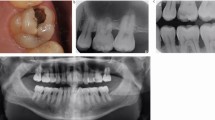Key Points
-
There have been concerns expressed about the decline in restorative care of primary teeth.
-
This study describes the care and resultant outcomes of the carious primary teeth of children who were regular patients of 50 GDPs in the North West of England.
-
Although extractions were common GDPs restored over 80 % of carious deciduous molars.
-
The bulk of carious teeth exfoliated naturally irrespective of whether they were restored or not.
-
The design of this study was limited but the results raise many important questions which require further investigation.
Abstract
Objective To describe the care and resultant outcomes of the carious primary teeth of children who regularly attend the General Dental Service (GDS).
Setting Four districts in the North West of England
Subjects and Materials A retrospective study of the case notes of 677 children who received their dental care from 50 general dental practitioners (GDPs). Each dentist must have had a minimum of 10 patients and a maximum of 20 patients whose care had been provided by the same dentist from or before the age of five to the age of 14. All of the children included in the study had a history of approximal caries. The outcomes of interest were extraction due to pain or sepsis, or exfoliation and whether or not a tooth had given rise to the prescription of a course of antibiotics. Teeth that did not have a history of extraction were assumed to have exfoliated naturally. Logistic regression models, taking into account the clustering of the teeth within patients, were fitted to compare the outcomes for restored and unrestored teeth according to size of lesion (one or two surface), age caries was first recorded and by tooth type.
Results A total of 4,056 teeth had been either recorded as carious or had received an intervention of some kind. Some 44.1% (N=1,789) of these teeth were extracted, however only 475 (11.7%) were extracted due to pain or sepsis. Of the teeth with a documented history of caries or restoration and for which an outcome was recorded (N=3,145), most first (81.1%) and second (84.3%) carious primary molars were filled during their lifetime, but only 40.5% of primary carious anterior teeth were filled. The majority of carious primary teeth exfoliated naturally. There was no difference in the proportions of teeth extracted due to pain or sepsis whether a carious tooth was restored or left unrestored, either by cavity type or by tooth type, after controlling for age when caries was first recorded. There was also no difference in the number of filled or unfilled carious teeth that caused a course of antibiotics to be prescribed.
Conclusions Treatment by extraction was common, but GDPs restored the majority of carious primary molar teeth of their regularly attending child patients. The bulk of carious teeth exfoliated naturally irrespective of whether they were filled or not. The reasons for these findings require further investigation.
Similar content being viewed by others
Log in or create a free account to read this content
Gain free access to this article, as well as selected content from this journal and more on nature.com
or
References
Nugent ZJ Pitts NB Patterns of change and results overview 1985/6–1995/6 from the British Association for the Study of Community Dentistry (BASCD) co-ordinated National Health Service surveys of caries prevalence. Comm Dent Health 1997; 14 (Supp 1): 30–54.
Curzon MEJ Pollard MA Do we still care about children's teeth? Br Dent J 1997; 182: 242–244.
Holloway PJ Lennon MA Mellor AC Coventry P Worthington HV The Capitation Study. 1. Does capitation encourage 'supervised neglect'? Br Dent J 1990; 168: 119–121.
Crawford PJM Davenport E Page J Williams S Restorative dentistry for children. In Ward P (ed). Setting Standards in Dental Care for Children Special Edition Dental Profile Dental Practice Board, Eastbourne 1997 8–10.
British Society of Paediatric Dentistry A policy document on management of caries in the primary dentition. Int J Paed Dent 2001; 11: 153–157.
Pitts NB Evans DJ Nugent ZJ The dental caries experience of 5-year-old children in the United Kingdom. Surveys co-ordinated by the British Association for the Study of Community Dentistry in 1997/98. Comm Dent Health 1999; 16: 50–56.
Milsom KM Tickle M Jenner AM Moulding G The identification of agreed criteria for referral following the dental inspection of children in the school setting. Br Dent J 1999; 186: 37–40.
Tickle M Williams MJ Jenner AM Blinkhorn AS The effects of dental attendance and socio-economic status on dental caries experience and treatment patterns in 5-year-old children. Br Dent J 1999 186: 135–137.
Tickle M Milsom KM Kennedy A Is it better to leave or restore carious deciduous molar teeth? A preliminary study. Primary Dent Care 1999; 6: 127–131.
Hawley GM Holloway PJ Measuring health behaviours – which tools should we use? Comm Dent Health 1995; 11: 129–130.
Whittle JG The provision of primary care dental general anaesthesia and sedation in the north west region of England, 1996-1999. Br Dent J 2000; 189: 500–502.
Department of Health A Conscious Decision. A review of the use of general anaesthetic and conscious sedation services in primary dental care London: HMSO 2000.
Cushing AM Sheiham A Maizels J Developing sociodental indicators – The social impact of dental disease. Comm Dent Health 1986; 3: 3–17.
Locker D The burden of oral disorders in a population of older adults. Comm Dent Health 1992; 9: 109–24.
Slade GD Spencer AJ Development and evaluation of the Oral Health Impact Profile. Comm Dent Health 1994; 11: 3–11.
Author information
Authors and Affiliations
Corresponding author
Additional information
Refereed paper
Rights and permissions
About this article
Cite this article
Tickle, M., Milsom, K., King, D. et al. The fate of the carious primary teeth of children who regularly attend the general dental service. Br Dent J 192, 219–223 (2002). https://doi.org/10.1038/sj.bdj.4801338
Received:
Accepted:
Published:
Issue date:
DOI: https://doi.org/10.1038/sj.bdj.4801338
This article is cited by
-
The in-practice prevention programme: an example of flexible commissioning from Yorkshire and the Humber
British Dental Journal (2022)
-
Impact of non-restorative cavity control on proximal carious lesions of anterior primary teeth on the tooth survival and patient-centered outcomes (CEPECO 2): study protocol for a non-inferiority randomized clinical trial
BMC Oral Health (2021)
-
Selection and validation of a classification system for a child-centred preference-based measure of oral health-related quality of life specific to dental caries
Journal of Patient-Reported Outcomes (2020)
-
Dental professionals’ experiences of managing children with carious lesions in their primary teeth – a qualitative study within the FiCTION randomised controlled trial
BMC Oral Health (2020)
-
Children and parents’ perspectives on the acceptability of three management strategies for dental caries in primary teeth within the ‘Filling Children’s Teeth: Indicated or Not’ (FiCTION) randomised controlled trial – a qualitative study
BMC Oral Health (2020)



